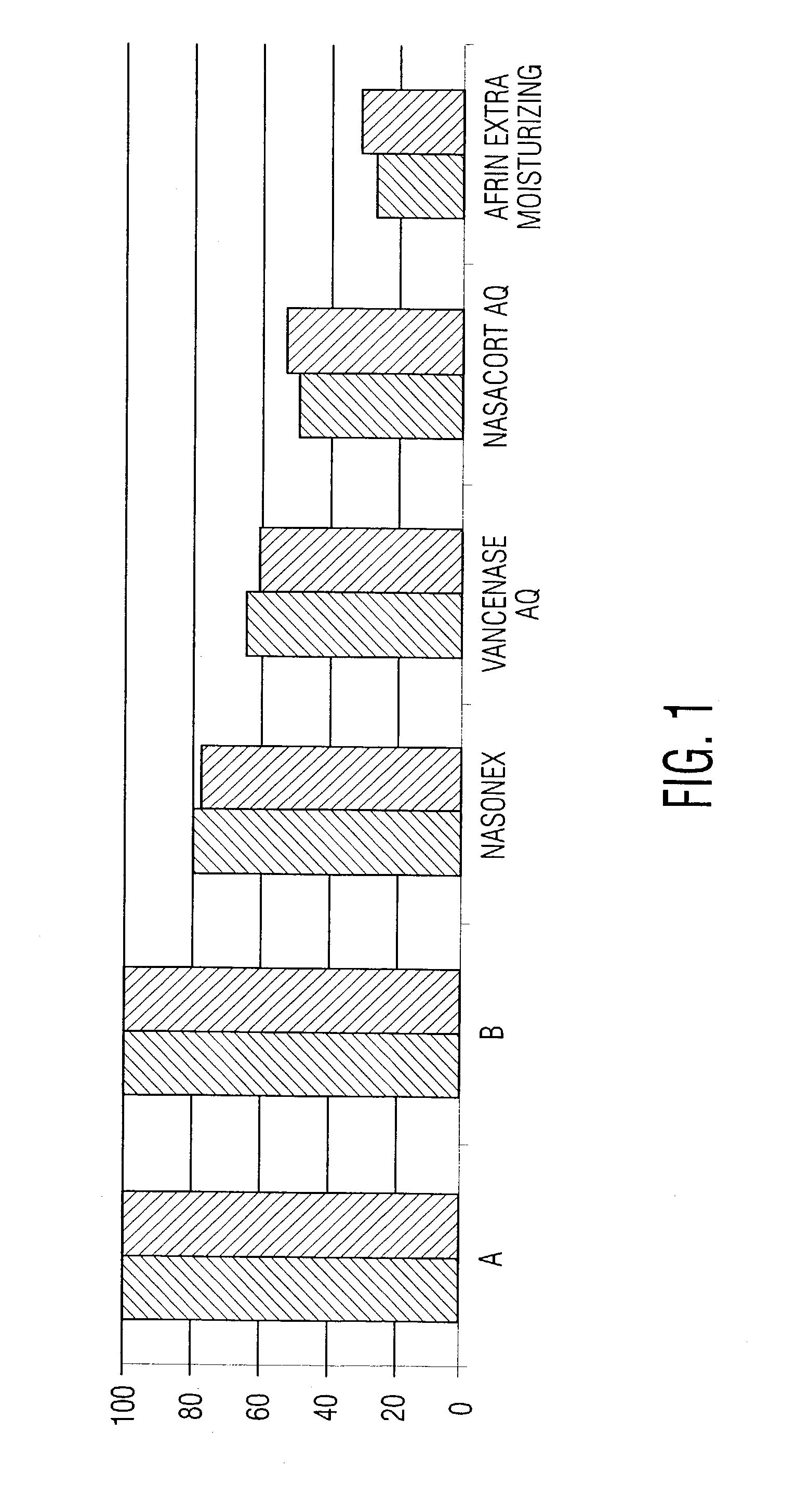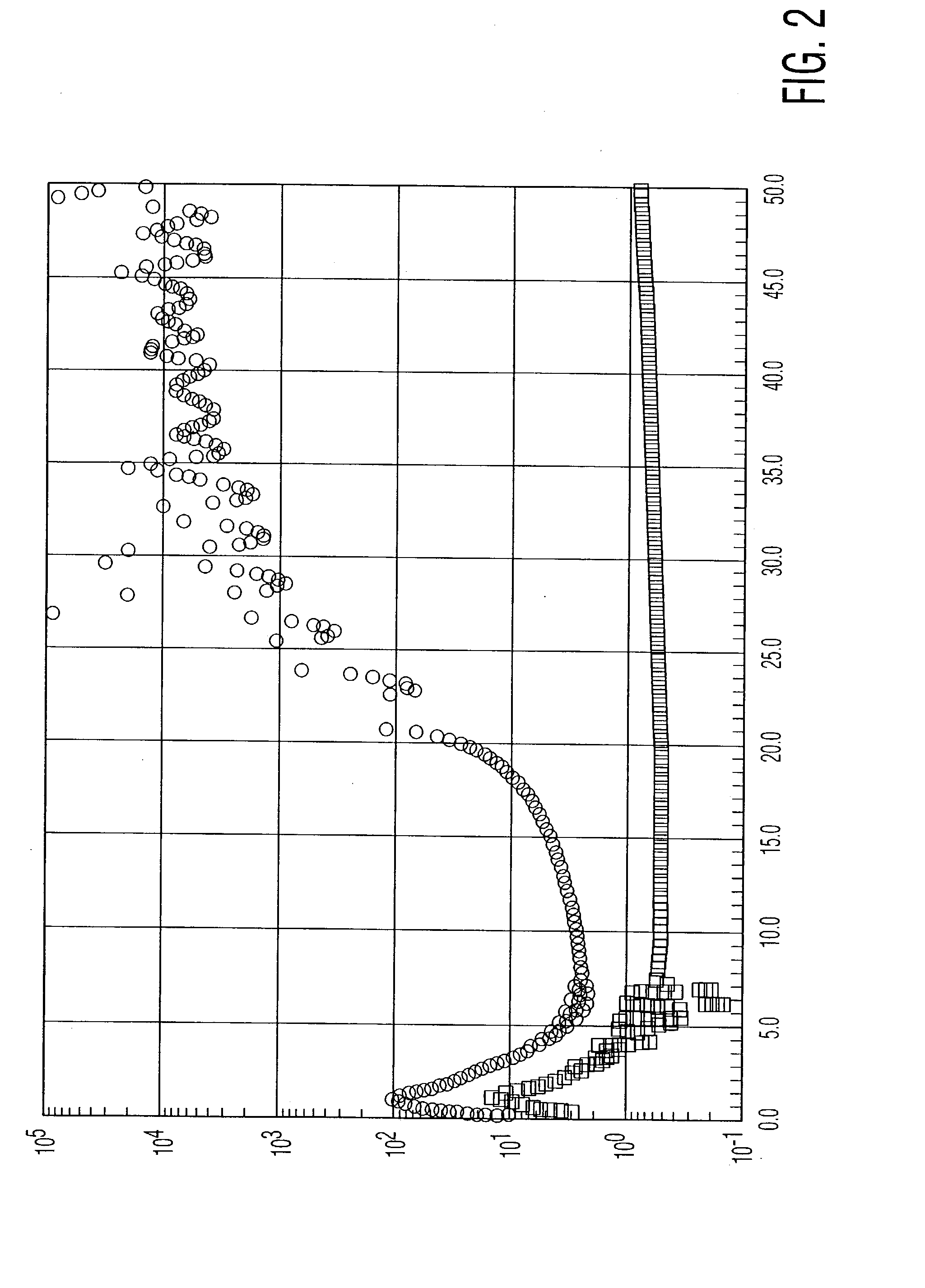Spray composition
a composition and spray technology, applied in the field of spray compositions, can solve the problems of low active agent efficiency, large portion of the active agent introduced into the nose is generally rendered unavailable for its intended use, and no reported application of this material in the composition, so as to relieve oropharyngeal discomfort, reduce formulation characteristic variations, and high viscosity
- Summary
- Abstract
- Description
- Claims
- Application Information
AI Technical Summary
Benefits of technology
Problems solved by technology
Method used
Image
Examples
example 2
[0040] Nasal spray compositions are prepared in accordance with the invention, using the general procedure of the preceding example and the following ingredients (where amounts are weight percentages):
2 Ingredient A B C Water 89.7229 90.2279 89.7229 Oxymetazoline hydrochloride 0.05 0.05 0.05 Avicel .TM.-591 3 3 3 Polyvinylpyrrolidone* 3 3 3 PEG-32** 5 5 5 Sodium phosphate, dibasic 0.0975 0.0975 0.0975 Sodium phosphate, monobasic 0.5525 0.5525 0.5525 Disodium EDTA 0.03 0.03 0.03 Benzalkonium chloride, 17% aq. solution 0.1471 0.1471 0.1471 Benzyl alcohol 0.25 0.35 0.3 Lemon flavor 0.15 -- --Glycerin 0.5 -- --Propylene glycol -- -- 0.5 Camphor --0.009 0.02 Menthol -- 0.027 0.06 Eucalyptol -- 0.009 0.02 *Plasdone .RTM. K29-32 sold by International Specialty Products, Wayne, New Jersey U.S.A. **CARBOWAX .RTM. PEG 1450 sold by Union Carbide Corporation, Houston, Texas U.S.A.
example 3
[0041] Nasal spray compositions are prepared in accordance with the invention, using the general procedure of preceding Example 1 and the following ingredients (where amounts are weight percentages):
3 Ingredient D E F G Water 95.8272 90.9492 92.9004 88.5102 Oxymetazoline hydrochloride 0.0488 0.0488 0.0488 0.0488 Avicel .TM.-591 2.9268 2.9268 2.9268 2.439 Polyvinylpyrrolidone* -- -- 2.9268 2.9268 PEG-32** -- 4.878 --4.878 Sodium phosphate, dibasic 0.0951 0.0951 0.0951 0.0951 Sodium phosphate, monobasic 0.539 0.539 0.539 0.539 Disodium EDTA 0.0293 0.0293 0.0293 0.0293 Benzalkonium chloride, 17% 0.1435 0.1435 0.1435 0.1435 aq. solution Benzyl alcohol 0.2439 0.2439 0.2439 0.2439 Lemon flavor 0.1463 0.1463 0.1463 0.1463 *Plasdone .TM. K29-32 sold by International Specialty Products, Wayne, New Jersey U.S.A. **CARBOWAX .TM. PEG 1450 sold by Union Carbide Corporation, Houston, Texas U.S.A.
example 4
[0042] Commercially available nasal spray compositions are tested against the composition of preceding Example 1, to identify differences in their dripping potentials. In the test, borosilicate glass test tubes are weighed, then clamped in an inverted vertical position. The nasal spray bottle is weighed, placed under the mouth of the test tube, sprayed twice and then immediately removed. After 60 seconds, the test tube is turned vertically to position the mouth at the top and is weighed to quantify the amount of nasal spray that did not drip out. The nasal spray bottle is weighed to determine the amount delivered by the two spray actuations, and the percentage of the delivered dose remaining in the test tube is calculated.
[0043] Results are as shown in the following table and in the graph of FIG. 1, where bars "A" and "B" represent the percentage of sprayed material remaining in the tube for two different preparations of the composition of Example 1. The remaining legends of the gra...
PUM
| Property | Measurement | Unit |
|---|---|---|
| weight percent | aaaaa | aaaaa |
| weight percent | aaaaa | aaaaa |
| weight percent | aaaaa | aaaaa |
Abstract
Description
Claims
Application Information
 Login to View More
Login to View More - R&D
- Intellectual Property
- Life Sciences
- Materials
- Tech Scout
- Unparalleled Data Quality
- Higher Quality Content
- 60% Fewer Hallucinations
Browse by: Latest US Patents, China's latest patents, Technical Efficacy Thesaurus, Application Domain, Technology Topic, Popular Technical Reports.
© 2025 PatSnap. All rights reserved.Legal|Privacy policy|Modern Slavery Act Transparency Statement|Sitemap|About US| Contact US: help@patsnap.com


